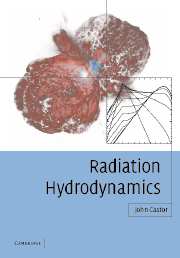Book contents
- Frontmatter
- Contents
- List of figures
- Preface
- 1 Introduction
- 2 A quick review of gas dynamics
- 3 Numerical hydrodynamics
- 4 Description of radiation
- 5 Steady-state transfer
- 6 The comoving-frame picture
- 7 Hydrodynamics with radiation: waves and stability
- 8 Radiation–matter interactions
- 9 Spectral line transport
- 10 Refraction and polarized light
- 11 Numerical techniques for radiation transport
- 12 Examples
- References
- Index
6 - The comoving-frame picture
Published online by Cambridge University Press: 18 February 2010
- Frontmatter
- Contents
- List of figures
- Preface
- 1 Introduction
- 2 A quick review of gas dynamics
- 3 Numerical hydrodynamics
- 4 Description of radiation
- 5 Steady-state transfer
- 6 The comoving-frame picture
- 7 Hydrodynamics with radiation: waves and stability
- 8 Radiation–matter interactions
- 9 Spectral line transport
- 10 Refraction and polarized light
- 11 Numerical techniques for radiation transport
- 12 Examples
- References
- Index
Summary
There is just one good reason for viewing the radiation field in the comoving frame of the fluid, and developing equations based on this picture, and it is an important one. It is that owing to the Doppler and aberration effects it is only in the comoving frame that the emissivity and absorptivity have the values specified by atomic physics. When the photorecombination process results in the emission of photons, only in the comoving frame will this emission be isotropic. Only in the comoving frame does the photoionization edge appear in the absorptivity at the same frequency for every angle, and is that frequency the one in the tables of atomic absorption energies. Isotropic emission and absorption in the comoving frame mean that the equilibrium intensity, (4.33), will be isotropic, and that therefore the flux will vanish. As mentioned before, the flux F in the fixed frame does not vanish no matter how opaque the medium may be. The plan of this chapter is to present the transformation relations for the various radiation quantities for going from the comoving frame to the fixed frame (or vice-versa), and to follow through some of the implications of these relations. The development will be carried out only to order u/c, not because the relativistic treatment is especially hard, but because we have no use for this when we are using Newtonian mechanics for the fluid equations. We note that all the complexities of comoving-frame transport arise from the space and time variation of the fluid velocity. Indeed, if the velocity is a uniform constant then the comoving frame is an inertial frame and all the earlier simple relations apply in it, just as in any other inertial frame.
- Type
- Chapter
- Information
- Radiation Hydrodynamics , pp. 102 - 137Publisher: Cambridge University PressPrint publication year: 2004



